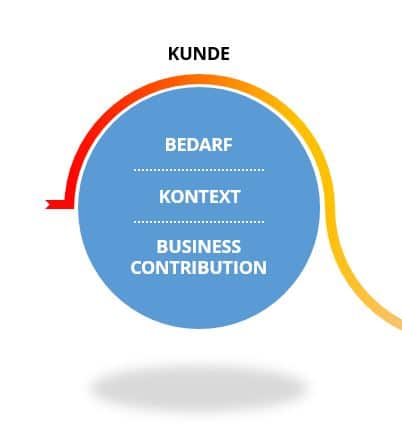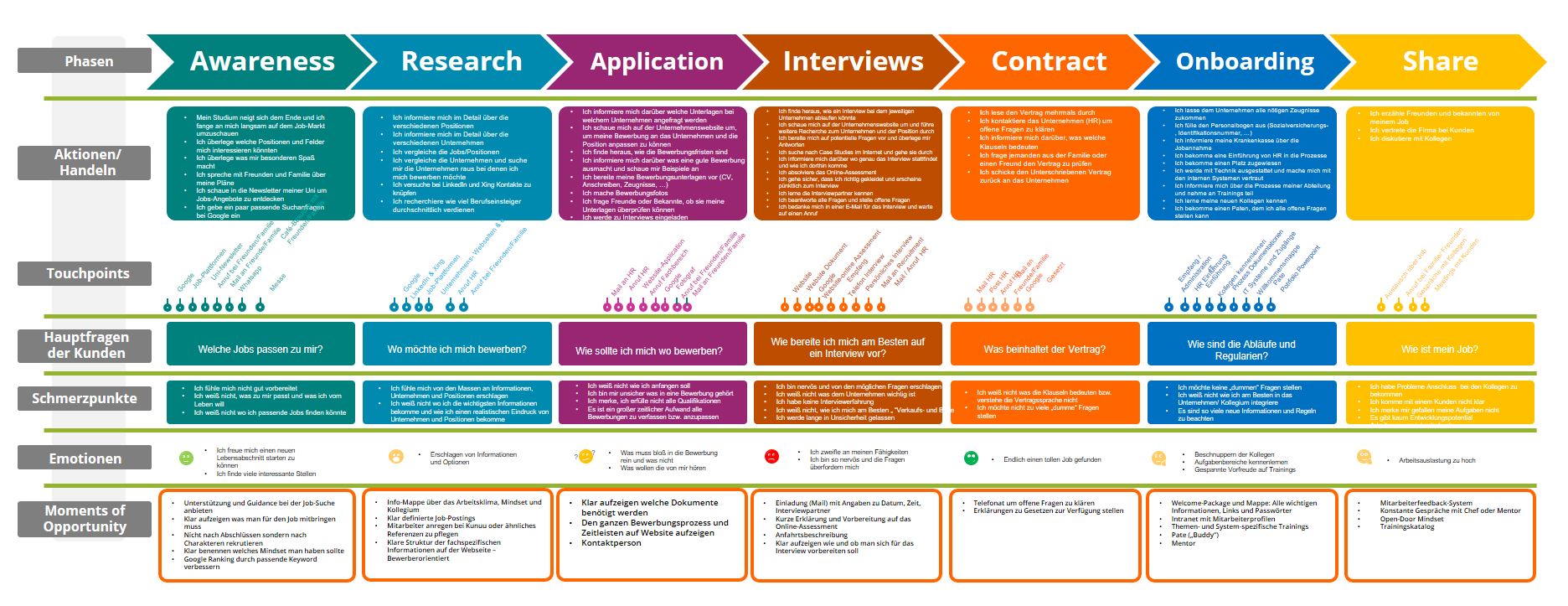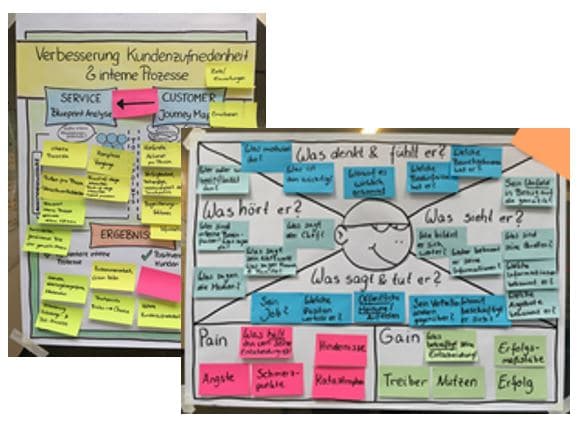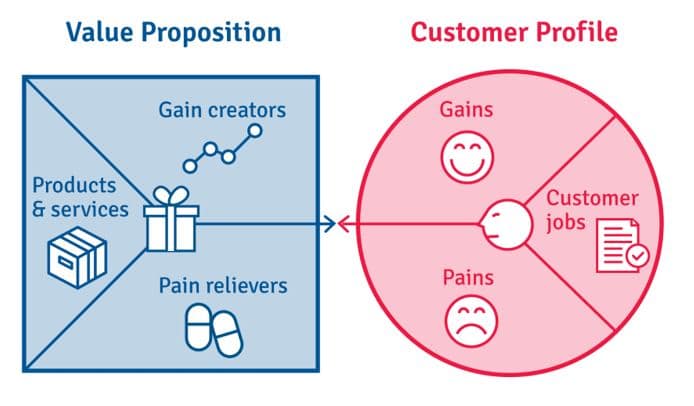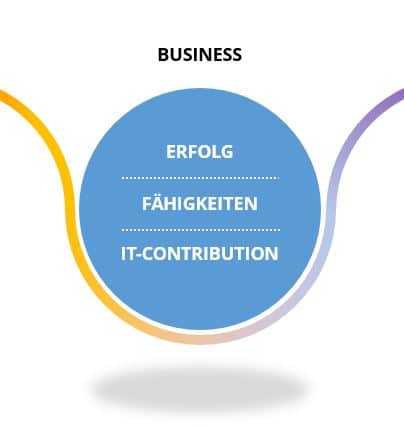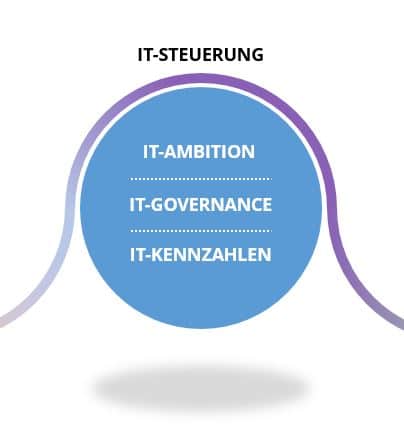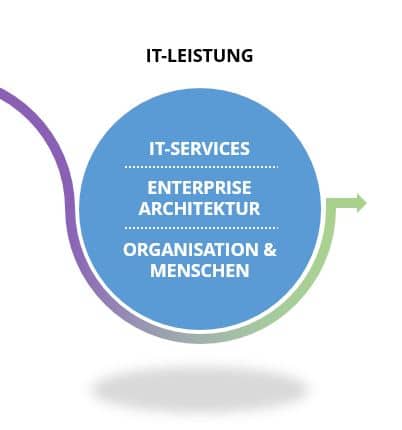Article Series “Agile IT Strategy Development”
The future IT strategy is agile! Why you should change your IT strategy, which requirements there are for the development process of your strategy, which stakeholders should be involved and which methods you should use to pick up the right priorities are explained by our experts in the article series “Agile IT Strategy Development”:
- Artikel 1: Why is there a need to change the IT strategy development?
- Artikel 2: What are the success factors and requirements for agile IT strategy development?
- Artikel 3: Who is involved in the agile IT strategy development process?
- Artikel 4: Which methods are suitable for the agile IT strategy development?
- Artikel 5: Key aspects of an agile IT strategy

Can there be any “generally valid focal points” or “generally valid contents” at all? Can this question be answered without falling into the bullshit bingo trap? We are convinced: yes!
Of course, there is no generally valid guideline as to what you should write in concrete terms – that, dear readers, you will have to find out for yourself. However, we can recommend a framework of focal points in the form of chapters that you should consider and fill with your specific content. And if you develop this framework using the methods described in the other articles and by integrating all the people mentioned, then there is a very good chance that your IT strategy will give your customers, your business and your IT organization a lot of pleasure.
So what should be the focus of an agile IT strategy?
In the past years, we have developed many IT strategies for our customers. For large corporations as well as for medium-sized companies. As a summary of our work, we now present our essence from many IT strategy projects and the application of many strategy templates: “mgm’s glorious 7 of IT strategy”.
- A description of your customer
- A description of your business
- A description of your control mechanism in IT
- A description of what you deliver to the business and the customer
These four points are framed by the following trio:
5. A measurable description of your actual and target stat of IT
6. A description of the 5 programs with which you want to implement your strategy
7. A list of the 5 biggest risks on your path and how to manage them
(Abb. 1 – „mgms glorreiche 7 der agilen IT-Strategie“)
But let us take a closer look at the individual areas. We will ask you questions that we believe you should answer as part of a good IT strategy.
Point 1: Description of your customers
So let’s start with point 1 of “mgm’s glorious 7 of IT strategy”: How can your customer be described? With a simple trio:
(Abb. 2 – Unterstruktur „Die Kunden Ihres Unternehmens“)
Where do you get this information from? Our suggestion: Talk to your marketing department. Maybe they have one or more “Value Proposition Canvas” (VPC) available, from which you can learn a lot about your company’s customers. No? Doesn’t your marketing department have one of these? Do you want to be the driver of digital transformation in your company? Then develop VPCs with the marketing department for your own IT purposes. Take advantage of design-thinking workshops with the departments/business units of your company. Use customer journey maps and service blueprints to develop your ideas for customer-centric IT solutions. Because to deduce your IT strategy, it is important to find out why the customer really needs your company and what your company promises the customer. This is where you can gain initial insights into how your IT can better help meeting the customer’s needs. A positive side effect: You align yourself further with the business, you strengthen your understanding of the business processes and deepen your thinking from the customer’s perspective.
(Abb. 3: Customer Journey Maps, Service Blueprints (Quelle: mgm), Value Proposition Canvas (Quelle: Internet))
Point 2: Description of your business
Next item from “mgm’s glorious 7 of IT strategy”: How to describe your business? With a simple trio as follows:
(Abb. 4 – Unterstruktur „Das Business Ihres Unternehmens“)
Talk to your departments about these 3 things! They are the basis for everything you should do in IT! What skills does your business need to be successful today? Which of today’s skills need to be protected and preserved in order to be successful tomorrow? Which additional skills does your business need to be successful? To what extent does your business need these skills? World class? Or rather “normal”? Does your business need these skills in a standard form? Or more specific/individual?
And now it gets more and more exciting: For which of these skills does your business need how much IT? And (so that you can set your priorities): If your business representative was the sole ruler of the business, in which of these skills would she/he invest (with a limited budget)? It is important to get “all” business representatives in one room to answer these questions. This is the only way to ensure that your business can prioritize sensibly. For this cascade of questions, we have developed an established workshop format that gives you all the freedom you need to respond to your corporate culture and pick up your business where it is today. If you enjoy this deduction, you can also develop this method into a Business Capability Model and thus improve the enterprise architecture.
Point 3: Description of the control mechanisms in IT
Point 3 of “mgm’s glorious 7 of the IT strategy”: While the first two sections deal a lot with the “why”, here you get into the “how” (from a business perspective!): How do you want to be? And how do you want to control IT so that your company can operate successfully? How can your control mechanisms in IT be described? With a simple trio as follows:
(Abb. 5 – Unterstruktur „Ihre Steuerungsmechanismen in der IT“)
First of all, you should be able to answer the (internal) why for your IT organization. What are the ambitions of your IT department / organization? What is your vision? Your mission? Give your employees a picture of why they get up every morning and deal with sometimes mundane things like administration, patch levels, hardware procurement, Excel spreadsheets, PowerPoint slides and sitting in meetings. Normally, your employees* experience anger, frustration and stress in addition to a lot of joy. What is the sense behind these activities? What is the main benefit generated by “the IT” for whom? Who is “the IT”? As IT, are you “the business”? Part of the business? Are you an enabler? Are you a pure IT service organization? Are you an IT service broker? How do you position yourself in relation to a possible CDO, CTO, COO? If you and your IT team can find good and clear answers to these questions (and don’t just pretend to do so from the top down) and don’t lose sight of continuity and the preservation of existing strengths, there is a good chance that your entire IT organization will stand together even in hard times and will work hard until a storm tames and the ship is back in safe waters.
And now we come to a dangerous term: “IT governance”. Why is this term dangerous in our view? Because the history of IT governance is a history of misunderstandings. Few terms in IT are interpreted so differently. We recommend that you make it easy here and take only the 3 components from the IT Governance universe that are important for most addressees:
- „Money makes the world go around“ (Liza Minnelli)/„the buck stops here“ (Harry S. Truman):
Where does the money come from? Who releases money? How are the costs charged? - „It is our choices that show what we truly are, far more than our abilities“ (J. K. Rowling):
Who makes which decisions? How do you make strategic, tactical and operational decisions? What does the committee structure look like? How do you control the providers? How do you manage the convergence of IT and OT (Operational Technology)? How do you bring this together? - „Draw conclusions from the conscience about the uncertain.“ (Solon):
According to which basic principles do you want to decide? What are your guidelines? What can your employees use as orientation for their decisions? If you have large clear lines, you give your IT organization security. Are you pursuing a cloud first position? Is standard software always the best choice for you? What degree of standardization do you want to achieve in principle? Is the customer always right? A number of core beliefs offer certainty in the unknown.
The last point in the trio of this section is your method for measuring quantifiable indicators. Because how did Peter Drucker put it? “You can’t manage what you can’t measure. How do you intend to measure your progress? How do you intend to measure your success? Do you use the classic balanced scorecard? Do you have KPIs (Key Performance Indicators)? CSFs (Critical Success Factors)? KGIs (Key Goal Indicators)? Do you use Operational Excellence or do you want to use John Doerr’s OKR system? We would like to recommend the latter and have dedicated a separate article to it. If you decide to use OKRs, it is also important to have clarity about who defines these goals. And how do you develop them? How do you want to lead at all? How often do you adjust these goals? Who is involved in defining the goals and how? Answer all these questions best on one or two pages of a presentation. There is a close connection with point 5 of the “glorious 7 of IT strategy”: Your initial situation and the target state you want to achieve with your IT strategy.
Point 4: Description of what you deliver to the customer and the business
But before we get to that, we would like to briefly touch on point 4 of “mgm’s glorious 7 of the IT strategy“: What do you deliver to your customers and your business, and with whom? Here too, we recommend a simple trio:
(Abb. 6 – Unterstruktur „Was liefern Sie mit wem an Ihre Kunden und Ihr Business?“)
Describe your IT organization and what you provide – your output, your value to the business and the company’s customers. What does the service catalogue look like today and what should it look like tomorrow? Do you deliver IT services? Business services? Perhaps you also supply IT products and have professional IT product management. In this case, do you actively manage the lifecycle of business or even customer-oriented services? Or do you passively provide your business with IT solutions and wait for faults and then rectify them? Do you describe your services with IT technical terms? Or can a user or customer of your company understand what you are offering him/her? Where do you want to go in this regard?
And what about your enterprise architecture? You certainly have “something” there – but what exactly and what are the concrete goals? How are customer processes, business processes, applications and infrastructures interrelated? How do you manage this interaction? In general, it is important to understand how you want to manage complexity. How do you want to manage the applications and technology of the Zoo? How do you integrate cloud solutions? How do you ensure speed, innovation, agility and security? Do you strive for bimodal IT? Or are you pursuing the goal of one-speed IT that can be adapted quickly and is still highly secure? How do you want to get there?
And last but not least, in this section: Show the readers how your IT organization is structured today and tomorrow, what your vertical integration looks like today and tomorrow, and who works for you today and tomorrow. If you want to develop an agile IT strategy in the future, it is important that you are properly positioned and have the right people on board. Are you set up according to Plan-Build-Run? Or according to Source-Make-Deliver? Or are you aligned according to the products and work in “Business or Product Lines” according to established DevOps principles? Are you (already / still) part of the business? Or is there a central IT? Are there key users or regional CIOs as demand organizations? Or do you develop the demand centrally for your central supply? You have certainly been dealing with your vertical integration for years. Here is the place to comment on this: What does your sourcing strategy look like? What cloud strategy are you pursuing? And very, very importantly: What about the skills of your people today and tomorrow? Which skills do you want to invest in? How many people do you have on board today? What is your goal for tomorrow? Here you can deepen your governance in relation to the “human” part: What kind of leadership do you want to establish? Do you want leadership at all levels or obedient work slaves? How much responsibility does the individual get, how much responsibility does the team get? How do you want to create innovation? What kind of people do you need to deliver the desired benefits to the customer and give the business the success it is hoping for? What kind of people do you need on the joint voyage on your ship to master all the storms and avoid the cliffs? Get to the point here! Rest assured that your employees will read this section carefully and pay attention to what is mere lip service and what is coherent, honest and integer leadership.
Point 5: Measurable description of your actual and target state of IT
When you are done with this part, then comes the masterpiece – the 5th point of “mgm’s glorious 7 of IT strategy”: What exactly do you want to change and how can you be measured?
Many companies find it difficult to be really specific when it comes to point 5 – although this is where the wheat is separated from the chaff to create a good and effective IT strategy. Because concrete, measurable and transparent goals make the IT strategy in many companies vulnerable. And unfortunately, many companies are still stuck in a culture of avoiding mistakes and punishing mistakes instead of experimenting, trying out and sometimes rejecting and adapting set goals. Because as we pointed out in the first article “Why agile IT strategy development is needed” and as Bob Dylan, the wise men of Asia and the ancient Greeks already knew: “The Times They Are a-Changin'”, “Truly constant is change alone” and “panta rhei – everything flows”. What they didn’t know, however, is how fast it all goes nowadays!
As already mentioned, most IT strategies fail to become really “good” here. Often, ambitious starts are made – and the longer the IT strategy is turned through the voting rounds, the more things are watered down. This is often due to a corporate culture that punishes mistakes and deviations from goals and ignores the opportunity to learn from and grow from these mistakes, instead of seeing constant change as incremental advancement and iterative development. Which is not to say that one should not become concrete here and work hard to achieve the set goals. Au contraire, messieurs, mesdames! Get concrete here! Make yourself measurable and transparent! For everyone! Make your goals public. Show that you are continuously working on them, do not stop being measured against your goals! If you are already on the path of agile management and have OKRs in place, it will be easy for you to become concrete here. Use the target state of IT as a constant driving force on the way forward to fulfill your ambitions, your mission for the customer and the company.
Point 6 & 7: Description of the 5 programs with which you want to implement your strategy & listing the 5 biggest risks on your path and how you manage them
We recommend that you conclude your document with points 6 and 7 of “mgm’s glorious 7 of the IT strategy”, because after all, your readers would also like to know what measures you intend to take to follow this path.
To do this, put at least 80%, preferably all of your projects into 5 large programs and then put the whole thing on an elaborate Gantt chart. People love plans! You can hang them up and sign them together with the whole team. We recommend program names that make the added value or the benefit for the business and/or the customer clearly understandable. Do not talk gibberish with technical project names here. This way you avoid the undesired impression that you are only concerned with yourself in IT and do not understand anything about the business. And please also manage these programs like programs, i.e. with program managers, program objectives and clear governance in case of conflicts between program and project within the framework of professional portfolio management. Last but not least, we would like to ask you for a favor that will make your life a lot easier. Please do not forget the 7th point of “mgms glorious 7 of IT strategy”: Your risks. Please do not pretend that everything you have written is set in stone. As mentioned at the beginning and in general, this is the trigger for the whole series of articles about agile IT strategy development: Nothing is more constant than change and never before has the speed of change been so high. So please don’t ignore the risks under which you hopefully developed this strategy agile. Call a spade a spade, and think carefully about how they will react to it. A transparent and good risk management often works wonders – and will help you become more agile.
And if you would like to know how to work out this content in a simple and pragmatic way and summarize it on 20-30 PowerPoint pages or even just on one page, please contact us. We will gladly help you.
If you are also interested in other content aspects of an IT strategy, i.e. if you would like to delve even deeper into the topic and thus, for example, learn about a simple way to create an IT organization that is suitable and effective for you, or if you would like to learn more about a pragmatic way to create a powerful business capability model, or if we have simply made you curious about our thoughts and our work, then get in touch with us.
PS: Ask yourself where we get our inspiration from? On the one hand, from our work with our customers, with whom we discuss, individually adapt, elaborate, develop and implement our ideas. On the other hand, from the many different templates, books and publications on IT strategy that can be found in bookshops and libraries around the world and in the Google universe. The IT Strategy Template by Gartner (in the person of Dave Aron), the CEB Ignition Guide to Strategic Planning for IT (by the CEB Enterprise Architecture Leadership Council) and the OKR book by John Doerr are just a few examples. And last but not least: from the discussions with our passionate consultants at mgm consulting partners. Our own internal development in various Communities of Practice is an immeasurable source of joy and inspiration. A huge thank you to all involved!
Source header image: Jukan Tateisi



